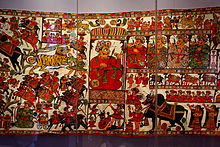Pabuji Ki Phad
| Pabhuji Ki Phad | |
|---|---|
| Rabari tribals | |
 |
|
| Affiliation | Hinduism |
| Abode | Rajasthan |
| Texts | Epic story of Pabuji |
| Region | Rajasthan |
Pabuji Ki Phad is a religious scroll painting of folk deities, which is used for a musical rendition of the only surviving ancient traditional folk art form, Phad painting in the world of the epic of Pabuji, the Rathod Rajput chief.Bhopas of Pabusar are the bards and also priests who are the traditional narrators of this art form. The Phad is also spelt as “Par.” This art form is popular in the Indian state of Rajasthan. Literally, 'Pabuji Ki Phad' translates into two versions namely, “The Screen of Pabuji or O, Read of Pabuji!. Pabuji is also known as "the Ascetic Deity of Sand Desert".
The three basic features associated with this art form are: the epic story of Pabuji, the Rathod chief of Rajasthan in the 14th century, who is extolled as an incarnation of Hindu God, and worshipped by the Rabari tribals of Rajasthan; the Phad or Par, which is a long scroll painting (or sewn) made on cloth, with the martial heroics of Pabuji richly displayed for worship; and the bard priests, known as the Bhopas (who belong to the cult of Pabhuji) of the nomadic tribe of Nayakas and specialists in narrating the story of the Pabuji in their sartorial best through the medium of the Phads used as a portable temple, all over the desert lands of the Thar in Rajasthan.
Pabuji is worshipped as a folk-deity. He lived in the 14th century (the 16th century is also mentioned) in a remote village known as Kulu in Rajasthan. Dhadal Rathore of village Kolu had four children: two boys, Buro the older and Pabuji the younger brother, and two girls, Sona and Pema. However, Pabuji was stated to be born to a nymph and as foretold by the nymph she was to return after 12 years as a mare to be with him. In his young age, Pabhuji fought against the Khici clan to evict them from his land that they had encroached and killed their leader, Jindrav Khinchi. During this period, he also acquired a black horse from Lady Daval (goddess worshipped in Kolu) of Charan Clan and it is believed that this horse was in the reborn form of his own mother. He then went on to defeat Mirza Khan who was indulging in the killing of cows, which are held sacred by the Hindus and Muslim plunderer named Muslim marauder Mirza Khan Patan and also protected honour of the womenfolk.
...
Wikipedia
